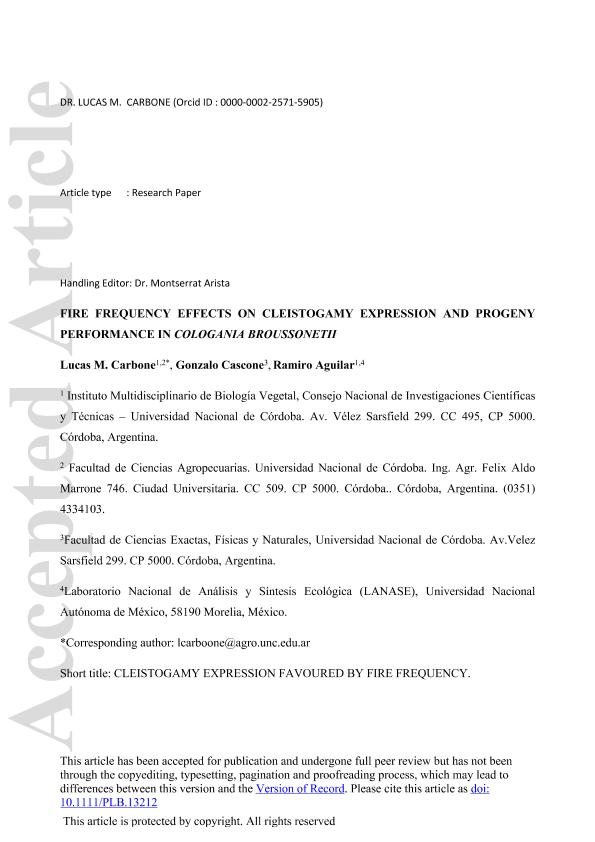Mostrar el registro sencillo del ítem
dc.contributor.author
Carbone, Lucas Manuel

dc.contributor.author
Cascone, Gonzalo
dc.contributor.author
Aguilar, Ramiro

dc.date.available
2021-02-15T15:49:34Z
dc.date.issued
2020-11-12
dc.identifier.citation
Carbone, Lucas Manuel; Cascone, Gonzalo; Aguilar, Ramiro; Fire frequency effects on cleistogamy expression and progeny performance in cologania broussonetii; Wiley Blackwell Publishing, Inc; Plant Biology; 12-11-2020; 1-29
dc.identifier.issn
1435-8603
dc.identifier.uri
http://hdl.handle.net/11336/125683
dc.description.abstract
Increased fire frequency usually erodes microenvironmental conditions causing a drastic limitation of edaphic resources. Thus, the production of permanently closed-small flowers (cleistogamous, CL) should increase in sites with high fire frequency as it implies a less-expensive reproductive-assurance strategy. However, because open, insect-pollinated flowers (chasmogamous, CH) have the potential capability to outcross via pollinators, CH progeny produced at any site should outperform selfed CL progeny.We evaluate the effect of fire frequency on the relative production of CL/CH flowers and fruits, and their seed-set, along with several progeny performance parameters in Cologania broussonetii (Fabaceae), a resprouting herb with dimorphic cleistogamy native to the Chaco Serrano. Fire frequency increased cleistogamy expression, reaching extreme levels in high fire frequency sites. Seed-set was similarly high for both CH and CL flowers in the unburned condition, while in burned sites the few developed CH flowers set more seeds than CL flowers. However, progeny performance was similar between CH and CL progeny at each and across all fire frequency conditions.Cleistogamy expression in C. broussonetii is maximized in abiotically degraded frequently burned habitats, although the selfed CL progeny is as successful as potentially outcrossed CH one. Fire frequency may decreased floral size and abundance selecting autogamous reproduction, which restricts not only the genetic potential of plant populations but also the resources offered to pollinators. At the community level, increased cleistogamy expression may potentially have negative implications for non-cleistogamous, more outcrossing species surviving in frequently burned environments
dc.format
application/pdf
dc.language.iso
eng
dc.publisher
Wiley Blackwell Publishing, Inc

dc.rights
info:eu-repo/semantics/openAccess
dc.rights.uri
https://creativecommons.org/licenses/by-nc-sa/2.5/ar/
dc.subject
CHACO SERRANO
dc.subject
CHASMOGAMOUS FLOWERS
dc.subject
DIMORPHIC CLEISTOGAMY
dc.subject
PROGENY PERFORMANCE
dc.subject
REPRODUCTIVE SUCCESS
dc.subject
REPRODUCTIVE ASSURANCE
dc.subject.classification
Ecología

dc.subject.classification
Ciencias Biológicas

dc.subject.classification
CIENCIAS NATURALES Y EXACTAS

dc.title
Fire frequency effects on cleistogamy expression and progeny performance in cologania broussonetii
dc.type
info:eu-repo/semantics/article
dc.type
info:ar-repo/semantics/artículo
dc.type
info:eu-repo/semantics/publishedVersion
dc.date.updated
2020-12-04T14:44:42Z
dc.identifier.eissn
1438-8677
dc.journal.pagination
1-29
dc.journal.pais
Reino Unido

dc.journal.ciudad
Londres
dc.description.fil
Fil: Carbone, Lucas Manuel. Consejo Nacional de Investigaciones Científicas y Técnicas. Centro Científico Tecnológico Conicet - Córdoba. Instituto Multidisciplinario de Biología Vegetal. Universidad Nacional de Córdoba. Facultad de Ciencias Exactas Físicas y Naturales. Instituto Multidisciplinario de Biología Vegetal; Argentina. Universidad Nacional de Córdoba. Facultad de Ciencias Agropecuarias; Argentina
dc.description.fil
Fil: Cascone, Gonzalo. Universidad Nacional de Córdoba. Facultad de Ciencias Exactas, Físicas y Naturales; Argentina
dc.description.fil
Fil: Aguilar, Ramiro. Consejo Nacional de Investigaciones Científicas y Técnicas. Centro Científico Tecnológico Conicet - Córdoba. Instituto Multidisciplinario de Biología Vegetal. Universidad Nacional de Córdoba. Facultad de Ciencias Exactas Físicas y Naturales. Instituto Multidisciplinario de Biología Vegetal; Argentina. Universidad Nacional Autónoma de México; México
dc.journal.title
Plant Biology

dc.relation.alternativeid
info:eu-repo/semantics/altIdentifier/url/https://onlinelibrary.wiley.com/doi/10.1111/plb.13212
dc.relation.alternativeid
info:eu-repo/semantics/altIdentifier/doi/http://dx.doi.org/10.1111/plb.13212
Archivos asociados
